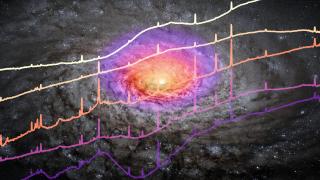Bibcode
de Sá-Freitas, Camila; Gadotti, Dimitri A.; Fragkoudi, Francesca; Coccato, Lodovico; Coelho, Paula; de Lorenzo-Cáceres, Adriana; Falcón-Barroso, Jesús; Kolcu, Tutku; Martín-Navarro, Ignacio; Mendez-Abreu, Jairo; Neumann, Justus; Blazquez, Patricia Sanchez; Querejeta, Miguel; van de Ven, Glenn
Referencia bibliográfica
Astronomy and Astrophysics
Fecha de publicación:
10
2023
Revista
Número de citas
16
Número de citas referidas
15
Descripción
When galactic discs settle and become massive enough, they are able to form stellar bars. These non-axisymmetric structures induce shocks in the gas, causing it to flow to the centre where nuclear structures, such as nuclear discs and rings, are formed. Previous theoretical and observational studies have hinted at the co-evolution of bars and nuclear discs, suggesting that nuclear discs grow `inside-out' and thereby proposing that smaller discs reside in younger bars. Nevertheless, it remains unclear how the bar and the nuclear structures form and evolve over time. The smallest nuclear discs discovered to date tend to be larger than ∼200 pc, even though some theoretical studies have reported that when nuclear discs form, they can be much smaller. Using MUSE archival data, we report, for the first time, two extragalactic nuclear discs with radius measurements below 100 pc. Additionally, our estimations reveal the youngest bars found to date. We estimate that the bars in these galaxies formed 4.50−1.10+1.60(sys)−0.75+1.00(stat) and 0.7+2.60(sys)−0.05+0.05(stat) Gyr ago, for NGC 289 and NGC 1566, respectively. This suggests that at least some disc galaxies in the Local Universe may still be dynamically settling. By adding these results to previous findings in the literature, we are able to retrieve a stronger correlation between nuclear disc size and bar length. We also derive a tentative exponential growth scenario for nuclear discs.
Proyectos relacionados

Huellas de la Formación de las Galaxias: Poblaciones estelares, Dinámica y Morfología
Bienvenida a la página web del g rupo de investigación Traces of Galaxy Formation. Somos un grupo de investigación amplio, diverso y muy activo cuyo objetivo principal es entender la formación de galaxias en el Universo de una manera lo más completa posible. Con el estudio detellado de las poblaciones estelares como bandera, estamos constantemente
Anna
Ferré Mateu

Actividad Nuclear en Galaxias: una Perspectiva 3D del Núcleo y su Entorno
Nuestro proyecto puede dividirse en dos líneas principales de investigación. En primer lugar, el estudio de los vientos producidos por cuásares luminosos oscurecidos y del impacto que estos tienen en sus galaxias anfitrionas (retroalimentación del AGN). Para ello hemos obtenido observaciones en el óptico e infrarrojo cercano con el Gran Telescopio
Cristina
Ramos Almeida